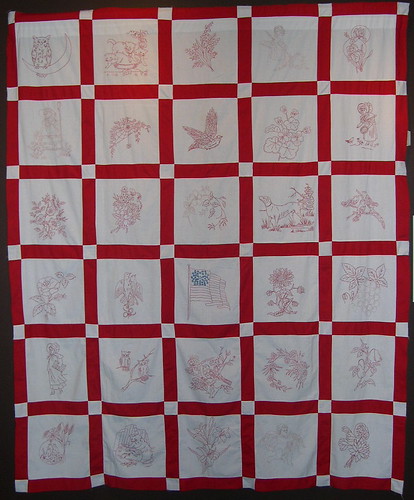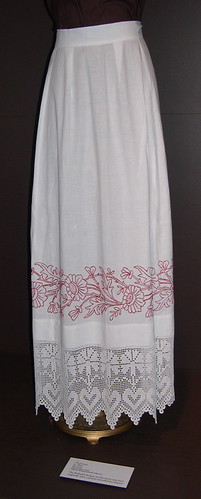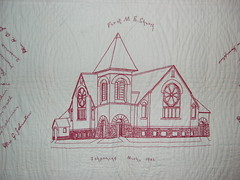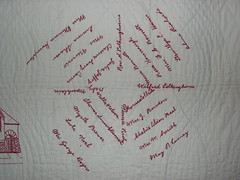
I really enjoyed seeing the pieces and reading the information provided which placed the work into a historical context. For example, the design from this block, from the Mikado Quilt came from the Ladies Home Journal, May 1889.

The quilt, maker unknown, is thought to be possibly made in Pennsylvania, ca. 1890 contains a variety of Asian-inspired motifs. Japanese-inspired designs became increasingly popular in American after the 1876 Philadelphia Centennial Exposition where more than nine million people were reported to have visited the Japanese pavilion.
The Blue Stars Flag Quilt, was made ca 1890. The flag in the center of this top has 41 stars--this was the official flag for only three days, after Montana was admitted to the United States on November 8, 1889. (Washington was admitted on November 11.)

The stars on the flag are the only blue embroidery on the quilt. I liked that.
 There were a couple other redwork quilts, both made by Michigan quilters in the 20's or 30's. One, called Redwork Quilt, features scenes from Nursery Rhymes. The other, Boy's Quilt, had multi-color embroidery of the kid-themed blocks.
There were a couple other redwork quilts, both made by Michigan quilters in the 20's or 30's. One, called Redwork Quilt, features scenes from Nursery Rhymes. The other, Boy's Quilt, had multi-color embroidery of the kid-themed blocks.There were also pairs of pillow shams and other examples besides quilts in the exhibit. I liked this ca. 1910 apron--both for the redwork and the filet crochet at the bottom.
There were a couple of examples of redwork quilts created as part of fund-raising efforts. The Ishpeming Fundraising Quilt, 1902-03, contains the names of 400 church members who contributed money to the First Methodist Episcopal Church of Ishpeming, Michigan.
The church is embroidered in the center of the quilt. The rest of the design is made up of an artful arrangement of the signatures.


The other fundraising quilt–for the Ku Klux Klan–was under glass. It also consisted of signatures and images of the KKK. The Museum label explained how textiles are important documents of history.
The materials, construction, design, pictorial imagery, signatures, the oral histories and related ephemera, and even condition of this quilt hold clues that strengthen and expand our understanding of quiltmaking, of Klan activity, and the social and cultural history of a particular community at a particular point in time.
The quilt was controversial. I suppose that's why it came with it's own ring full of Frequently Asked Questions.

You can see all my photos from the exhibit in the Flickr set Redwork Show.

2 comments:
Wow! That is a fabulous exhibit.Are all the redwork pieces owned by the museum or were they "on loan" from people in the community?
Not really a red-worker myself, but very interested in quilt and needle history. We recently saw some quilted items at Birmingham UK museum's store, and one from 17th or 18th century (I can't remember, but can look it up if you're interested) was a red-worked jacket! It had very interesting images of animals and oriental-looking people, some of whom appeared to be drinking tea! If you cntact me with your e-mail, I'll send you a few pictures.
Post a Comment